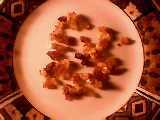Hawaiian - Polynesian Mysticism
The Menehune
(also known as Nawao)
Menehune are the "Little People" of Hawaii, similar to pixies or trolls
According to Wikipedia:
In Hawaiian mythology, the Menehune [pronounced meh-neh-HOO-neh] are said to be a people, sometimes described as dwarfs in size, who live in the deep forests and hidden valleys of the Hawaiian Islands, far from the eyes of normal humans. Their favorite food is themaiʻa (banana), but they also like fish.
The Menehune were said to be superb craftspeople. Legends say that the Menehune built temples (heiau), fishponds, roads, canoes, and houses. They are said to have lived in Hawaiʻibefore settlers arrived from Polynesia many centuries ago.
In Beckwith's Hawaiian Mythology, there are references to several other forest dwelling races: the Nawao, who were large-sized wild hunters descended from Lua-nuʻu, the mu people, and the wa people.[1]
Some early scholars theorized that there was a first settlement of Hawaiʻi, by settlers from the Marquesas Islands, and a second, from Tahiti. The Tahitian settlers oppressed the "commoners", the manahune in the Tahitian language, who fled to the mountains and were called Menahune. Proponents of this theory point to an 1820 census of Kauaʻi by Kaumualiʻi, the ruling Aliʻi Aimoku of the island, which listed 65 people as menehune.[2]
Folklorist Katherine Luomala believes that the legends of the Menehune are a post-European contact mythology created by adaptation of the term manahune (which by the time of the settling of the Hawaiian Islands had acquired a meaning of "lowly people" or "low social status" and not diminutive in stature) to European legends of brownies.[3] Menehune are not mentioned in pre-contact mythology; the legendary "overnight" creation of the Alekoko fishpond, for example, finds its equivalent in the legend[4] about the creation of a corresponding structure on Oʻahu, which was supposedly indeed completed in a single day - not by menehune, but, as a show of power, by a local aliʻi who demanded every one of his subjects to appear at the construction site and assist in building.
Source: Wikipedia contributors, "Menehune," Wikipedia, The Free Encyclopedia, http://en.wikipedia.org/w/index.php?title=Menehune&oldid=483629985 (accessed March 25, 2012).
The Menehune were said to be superb craftspeople. Legends say that the Menehune built temples (heiau), fishponds, roads, canoes, and houses. They are said to have lived in Hawaiʻibefore settlers arrived from Polynesia many centuries ago.
In Beckwith's Hawaiian Mythology, there are references to several other forest dwelling races: the Nawao, who were large-sized wild hunters descended from Lua-nuʻu, the mu people, and the wa people.[1]
Some early scholars theorized that there was a first settlement of Hawaiʻi, by settlers from the Marquesas Islands, and a second, from Tahiti. The Tahitian settlers oppressed the "commoners", the manahune in the Tahitian language, who fled to the mountains and were called Menahune. Proponents of this theory point to an 1820 census of Kauaʻi by Kaumualiʻi, the ruling Aliʻi Aimoku of the island, which listed 65 people as menehune.[2]
Folklorist Katherine Luomala believes that the legends of the Menehune are a post-European contact mythology created by adaptation of the term manahune (which by the time of the settling of the Hawaiian Islands had acquired a meaning of "lowly people" or "low social status" and not diminutive in stature) to European legends of brownies.[3] Menehune are not mentioned in pre-contact mythology; the legendary "overnight" creation of the Alekoko fishpond, for example, finds its equivalent in the legend[4] about the creation of a corresponding structure on Oʻahu, which was supposedly indeed completed in a single day - not by menehune, but, as a show of power, by a local aliʻi who demanded every one of his subjects to appear at the construction site and assist in building.
Source: Wikipedia contributors, "Menehune," Wikipedia, The Free Encyclopedia, http://en.wikipedia.org/w/index.php?title=Menehune&oldid=483629985 (accessed March 25, 2012).



